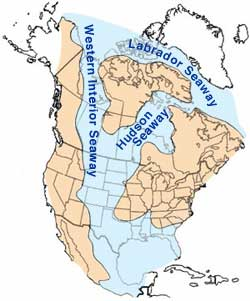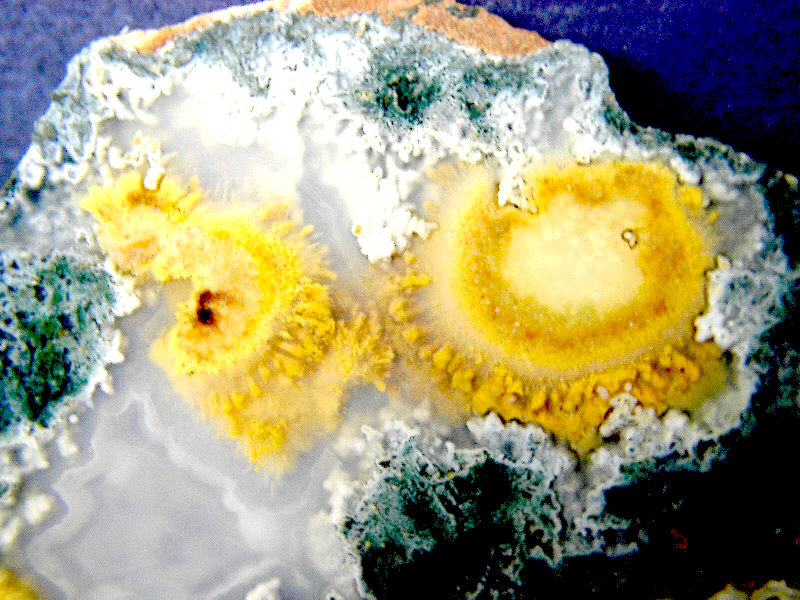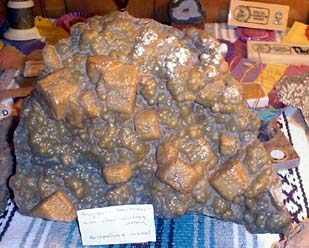A BRIEF GEOLOGICAL DESCRIPTION OF THE NEEDLE PEAK AREA
Needle Peak, or the official name being Sierra Aguja, is located about seven miles due south of Terlingua, Texas and is mostly outside the boundary of the Big Bend National Park. The peak and its general surroundings consist of a complicated series of lava flows, ash deposits, and ash flows within the Tertiary Age Chisos Formation Series. The source of these lava flows has generally been accepted as coming from the Volcanic Center area several miles to the east in the Chisos Mountains within the Big Bend National Park.

Fig.1 Western Interior Seaway during the Cretaceous Period.
In the Early Cretaceous Age, most of the western part of North America was inundated by the Western Interior Seaway (see Fig. 1): the southern part being a part of the Tethys Sea, which included the Gulf of Mexico area. Flowering plants and water, land and air reptilian dinosaurs were being developed. The Cretaceous sea shore line was aligned approximately north - south along the vicinity of where Needle Peak is now located. The land mass was to the west and there were no mountain ranges until later in the Tertiary Age: therefore, there were no intermontane lakes, but there were numerous offshore lagoons, etc... By the Late Cretaceous the dinosaurs had reached their zenith. A general uplifting created many clay formations within the area now recognized as the Big Bend of Texas. These clay formations grade upward into ever-increasing amounts of volcanic ash material.
Over the 75 million years or so of the Cretaceous Period, these seas receded and grew along with the rising and sinking of the continent. All this time they were continuously depositing sediments of limestone, shale, and clays. Near the end of the Cretaceous Period and early in the Tertiary Period there began continuous uplifting and rising in elevation. This rising of the ranges also meant the seas were shrinking, and were becoming smaller and smaller bodies of water. In the Big Bend area this spelled the beginning of the end to the sediments being continuously deposited.
In the Eocene period of the Tertiary (about 45 MYA), when the Rocky Mountains were being uplifted, thrust faults and general uplifts were also slowly being formed in this area. First, volcanic eruptions began depositing ash in the sea and near-shore, burying ancient forests. Pore of trees were filled with silica dissolved from the ash, thus forming petrified wood. Next, Bee Mountain basaltic lavas began covering the area extending west and southwest as far away as San Carlos, Mexico and northward into the present day Bofecillos Mountains. These hot basaltic lavas contained gases that created many gas “pockets”, later to be filled with agate. The larger agates are generally found in the very large spaces within the brecciated tops and bottoms of the flows. Most of these lavas were also intermittently overlain with various ash-fall tuff materials, (called ignimbrites). Still more ash is deposited. Lastly, capping Needle Peak is the Tule Mountain Trachyandesite member: a massive, dense lava material.
In the Pliocene, or later, period of the Tertiary(less than 5-10 MYA), large scale faulting and folding from the Laramide Orogenic uplifting, and the later Basin and Range faulting (or NW to SE mountain ranges), created many new intermontane lakes. The largest and most extensive local lake was called the Ross Maxwell Lake, named after Dr. Ross Maxwell, a noted geologist and first superintendent of the Big Bend National Park. The water level of Lake Ross Maxwell was high and above the tops of present-day Needle Peak and Tule Mountain.

Fig.2 Two brilliant Pom-Pom bursts from Needle Peak.
Long before these lakes were being created, hot water rising from near-surface underlying magma deposited orthorhombic, and sometimes pseudo-hexagonal, aragonite crystals. These aragonite crystals, when deposited as hair-like acicular radiating clusters will later become the sun-like bursts of the beautiful Pom-Pom agates(see Fig. 2). Apparently these aragonite crystals must have come up through the faulting and from the underlying hot mass about the same time as the pressure was being relieved deep underground. As happened in the general area of the Woodward Ranch agates, the much later downward-moving, silica-bearing, low-temperature lake water moving through the overlying ash beds dissolved and re-deposited the agate material as gel. This gel in each cavity, or gas pocket, when reacting with the particular chemicals and minerals in the cavity lava walls touching it, upon solidification, determined which of the variety of agate would develop in that particular gas pocket or cavity.
Most of the agates found in the Needle Peak lava flows are clear-to-yellow agates, green-to-golden yellow moss agate, yellow and green jaspers, and banded agates; however, many of the agates are surrounded by the massive form with the centers filled by the agate and may also have the Pom-Pom bursts. Also found, when any aragonite clusters were enclosed within these gels, is the most spectacular Pom-Pom agate(Fig. 2), with its beautiful red and yellow sagenitic bursts.

Fig. 3 Chalcedony pseudomorph-after-aragonite crystals mineral specimen from the Rock Shop page.
Another rare find from Needle Peak has been the specimen also posted on the Rock Shop page of this web site (Fig. 3). Orthorhombic aragonite as pseudo-hexagonal twinned crystals was coated with chalcedony (agate). The aragonite was later dissolved out leaving only the shape of the aragonite crystal. This chalcedony-coated pseudomorph-after-aragonite specimen is almost a one-of-a-kind trophy. Only a few smaller similar pieces have been found to date.
J.F. Woodward II & T.R. Woodward (4/2003)(Updated 6/2009)
REFERENCES:
Geology of the Big Bend Area, Texas, Publication 72-59, 1972 (reprint of Publication 65-51 with additions, 1965),
West Texas Geological Society
The Big Bend of the Rio Grande, Guidebook 7, by Ross A. Maxwell, Bureau of Economic Geology,
Austin, Texas, First printing 1968.
Return to ROCK HUNTING
Return to the HISTORICAL INTERESTS page

© Tommy R. Woodward
All rights reserved.



